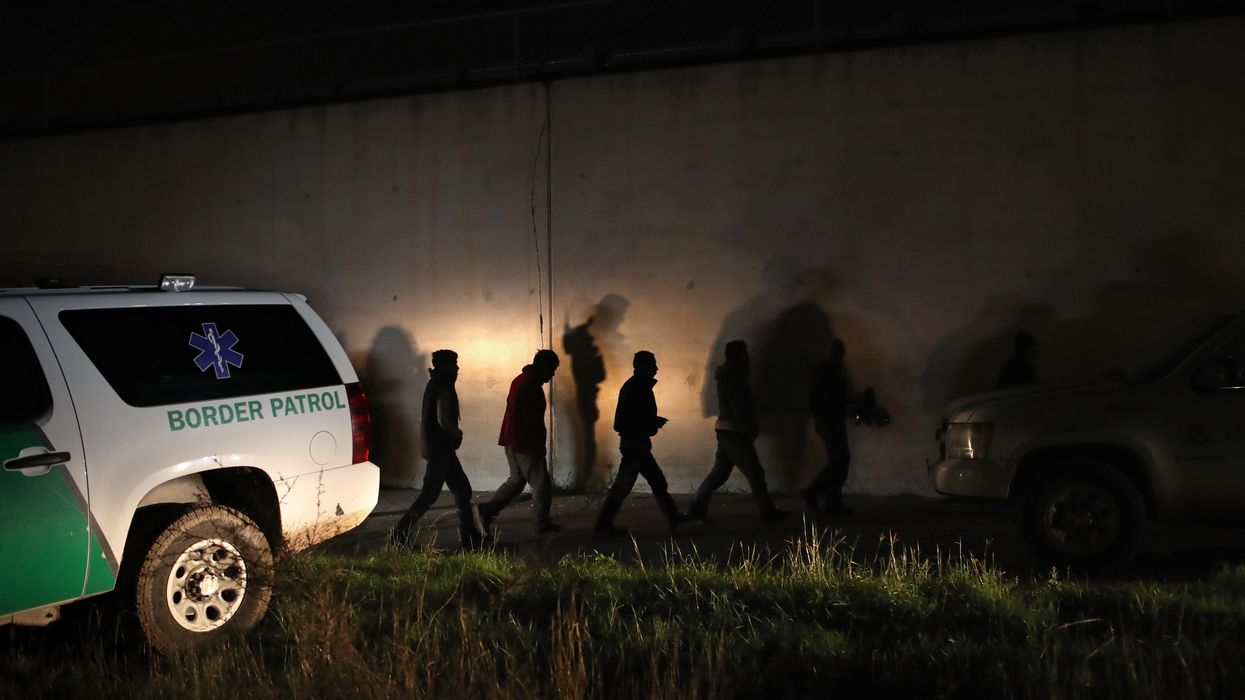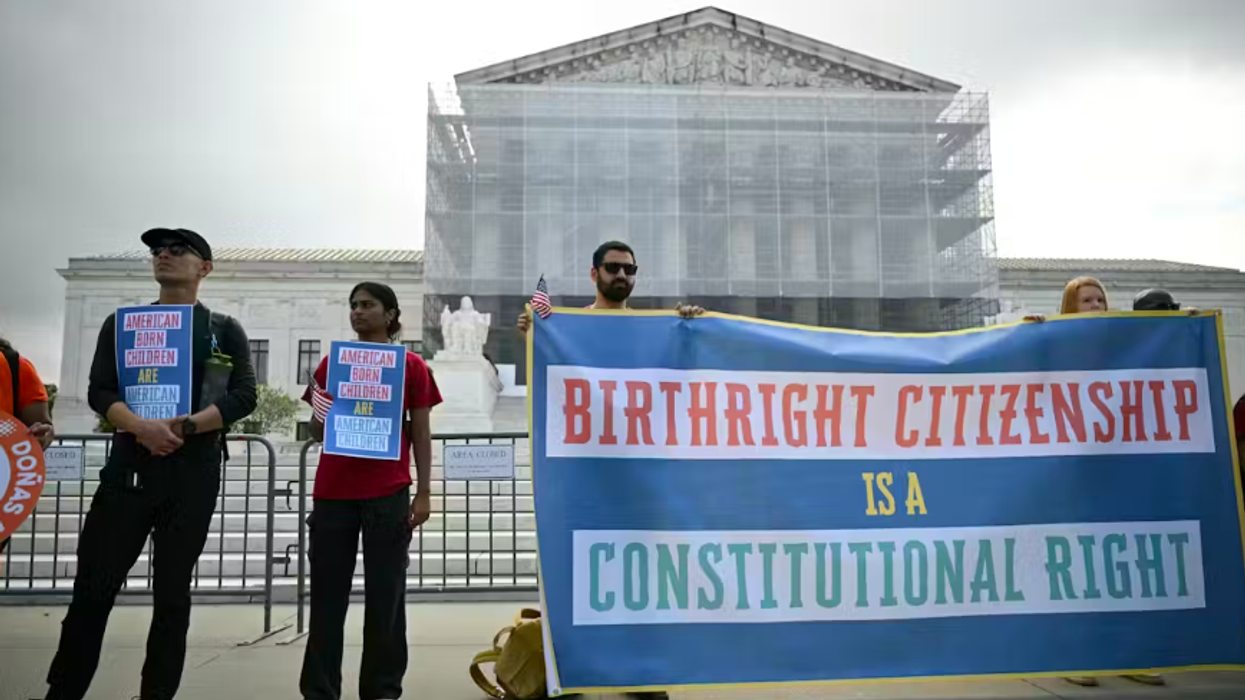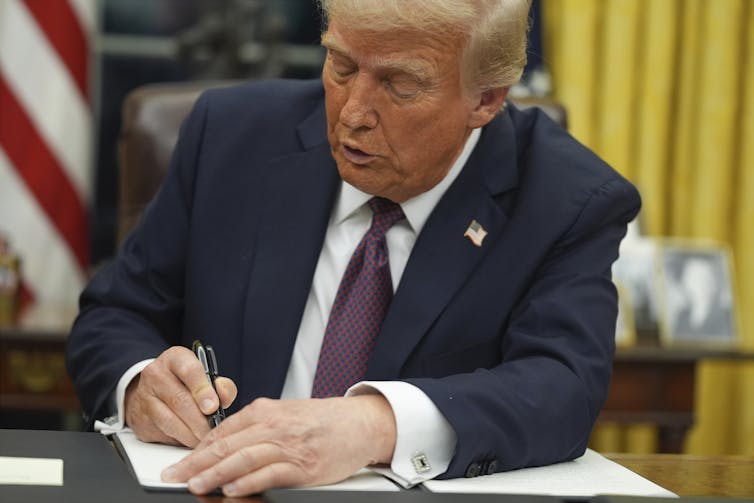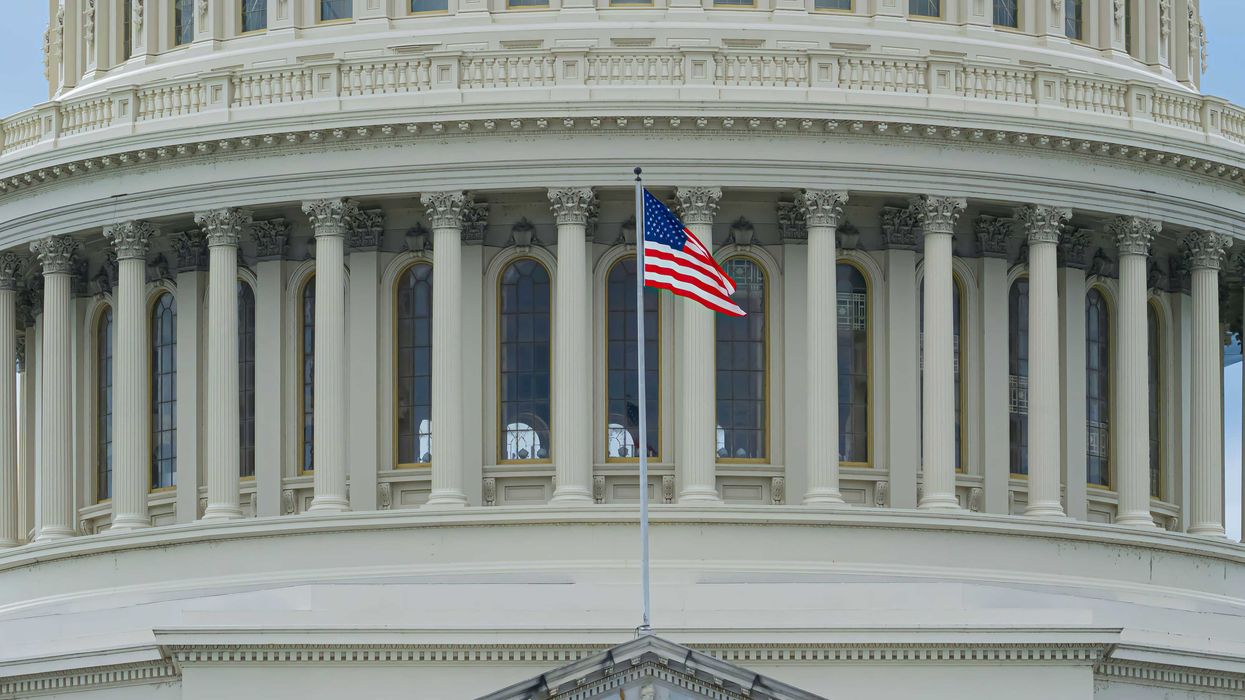We received a question through our Instagram account asking "if it's true what people say" that President Barack Obama deported more immigrants than Donald Trump. To answer our follower, Factchequeado reviewed the public deportation data available from 1993 to June 2025, to compare the policies of both presidents and other administrations.
Deportation statistics ("removals") are not available in a single repository, updated information is lacking, and there are limitations that we note at the end of this text in the methodology section.
Immigration and Customs Enforcement (ICE) does not have publicly available deportation figures for Trump's second term. It has data through December 2024, but not all of it is in the same link or in a statistical record that breaks it down by year.
Because of this, we obtained the number of deportations from January to June 2025 via a Freedom of Information Act (FOIA) by the Deportation Data Project, an academic and litigation initiative that collects and publishes datasets on U.S. government immigration control. The project is led by David Hausman, professor at UC Berkeley School of Law, Graeme Blair, professor at the University of California, Los Angeles (UCLA), and Amber Qureshi, an attorney specializing in federal immigration and FOIA litigation.
The Deportation Data Project leaders are concerned about the reliability of ICE's record regarding the deportation table from late June 2025: "It may not include all relevant records." They warn that associated fields, such as departure dates, "may also create an incomplete picture of deportations."
This demonstrates the limitations in accessing and analyzing the data.
What 30+ Years of Deportations Show Across 5 Presidents
Despite the challenges posed by current migration figures, data compiled and analyzed by Factchequeado shows that President Obama deported more immigrants than any other president in the last three decades.
Obama's immigration policies primarily focused on deporting immigrants with criminal charges and those considered national security threats, especially during his final years in office. By contrast, under President Trump, criminal priorities were eliminated, categorizing all undocumented individuals as deportable.
For instance, in this article, we explained that 80% of immigrants taken to detention centers in the first months of Trump's second term had no criminal record. Yet authorities publicly describe them as "the worst of the worst." Additionally, detentions of immigrants without crimes rose from 1,048 in January 2025 to 11,972 in June 2025.
Our analysis covers fiscal year 1993 through June 26 of fiscal year 2025, encompassing the administrations of Democrat Bill Clinton, Republican George W. Bush, Democrat Barack Obama, Democrat Joe Biden, and Republican Donald Trump.
We provide a breakdown of the statistics by president and by period of government.
Bill Clinton (1993-2000) - 8 years
863,958 deportations | Annual average: 107,994 | Daily average over 8 years: 296
All figures are based on fiscal years (October-September)
- FY 1993: 42,469 deportations (125/day).
- FY 1994: 45,621 deportations (125/day).
- FY 1995: 50,873 deportations (139/day).
- FY 1996: 69,588 deportations (191/day).
- FY 1997: 114,292 deportations (313/day).
- FY 1998: 172,547 deportations (473/day).
- FY 1999: 180,101 deportations (493/day).
- FY 2000: 188,467 deportations (516/day).
Context of the period: Under Clinton, deportations focused primarily on people with criminal backgrounds and immigration violations. The Illegal Immigration Reform and Immigrant Responsibility Act of 1996 expanded deportation categories and reduced available legal defenses.
George W. Bush (2001-2008) - 8 years
2,021,965 deportations | Annual average: 252,745 | Daily average over 8 years: 692
- FY 2001: 189,026 deportations (518/day).
- FY 2002: 165,168 deportations (453/day).
- FY 2003: 211,098 deportations (578/day).
- FY 2004: 240,665 deportations (659/day).
- FY 2005: 246,431 deportations (675/day).
- FY 2006: 280,974 deportations (770/day).
- FY 2007: 319,382 deportations (875/day).
- FY 2008: 369,221 deportations (1,012/day).
Context of the period: Following the 9/11 terrorist attacks on the Twin Towers in 2001, Bush prioritized deportations for national security reasons. He expanded the operations of the newly created ICE (2003) and intensified workplace raids. Deportations included both criminals and those accused of civil immigration violations.
Obama's First Administration (2009-2012)
1,589,451 deportations | Annual average: 397,362 | Daily average: 1,088
- FY 2009: 389,834 deportations (1,068/day).
- FY 2010: 392,862 deportations (1,076/day).
- FY 2011: 396,906 deportations (1,087/day).
- FY 2012: 409,849 deportations (1,123/day).
In 2012, a historic peak was reached, with an average of 1,123 deportations per day. This unprecedented figure led immigrant organizations to label Obama the “Deporter in Chief.”
Context of the period: Obama's first administration maintained the Secure Communities program launched in 2008 under Bush's presidency, a system where local police sent fingerprints to the FBI for identification, and the FBI sent the information to ICE to detect immigrants without legal status or with deportation orders. Deporting people with serious crimes and recent border crossers became a priority. Expulsions of immigrants without
criminal records in the country's interior decreased.
However, of the 375,000 immigrants expelled during the 6 years the program operated (active until 2014), more than 70% did not have crimes considered a national security threat, according to data from Syracuse University's TRAC Center (Transactional Records Access Clearinghouse).
At a time when he faced criticism for the high number of deportations, Obama approved the Deferred Action for Childhood Arrivals (DACA) program in June 2012.
Obama's Second Administration (2013-2016)
1,160,255 | Annual average: 290,063 | Daily average: 794
FY 2013: 368,644 deportations (1,010/day).
FY 2014: 315,943 deportations (866/day).
FY 2015: 235,413 deportations (645/day).
FY 2016: 240,255 deportations (658/day).
Context of the period: During the first fiscal year of Obama's second administration, thousands of immigrants were deported for entering without authorization (46,759 cases), a misdemeanor; driving under the influence of alcohol (29,852 cases); and for traffic violations (15,548 cases), despite the goal being to focus on level 1 criminals.
In 2014, Secure Communities closed, and DHS created the Priority Enforcement Program (PEP) with 4 categories for deportation:
- Priority 1: national security threats (terrorists, spies), dangerous criminals, and recent border arrivals after January 1, 2014.
- Priority 2: people with an extensive history of immigration violations (those who had recently crossed the border but were not priority 1).
- Priority 3: immigrants with minor crimes but sentences of more than 90 days (DUI, domestic violence, theft, etc.).
- Priority 4: people with final deportation orders issued after January 1, 2014.
- With the new priority system, deportations dropped in the last three years of his administration to less than 1,000 per day.
The Obama years: From 2009 to 2016, his administration deported 2,749,706 individuals, averaging 343,713 deportations per year—the highest in 32 years. In 2012, the daily peak reached 1,123 deportations.
Trump's First Administration (2017-2020)
935,346 deportations | Annual average: 233,836 | Daily average: 641
- FY 2017: 226,119 deportations (620/day).
- FY 2018: 256,085 deportations (702/day).
- FY 2019: 267,258 deportations (732/day).
- FY 2020: 185,884 deportations (509/day).
Context of the period: Trump reversed the changes with PEP, and his administration eliminated the DHS's 4 deportation priority categories. He signed an executive order to return to the Secure Communities system and arrests intensified in the country's interior. Deportations due to traffic violations increased again (138% after 9 months of the government change).
He implemented, with the endorsement of former Mexican President Andrés Manuel López Obrador, the "Remain in Mexico" policy, a program that forced non-Mexican asylum seekers to wait in Mexico for months or years while U.S. immigration courts resolved their cases.
Migrant communities, including families with children, set up tents on the Mexican side of the border and were exposed to extortion, kidnapping, and other crimes. The measure faced judicial restrictions.
Joe Biden (2021-2025) - 4 years
545,252 deportations | Annual average: 136,313 | Daily average: 373
- FY 2021: 59,011 deportations (162/day).
- FY 2022: 72,177 deportations (198/day).
- FY 2023: 142,580 deportations (391/day).
- FY 2024: 271,484 deportations (744/day).
Context of the period: Biden ordered a 100-day pause on interior deportations for people with final removal orders, except for national security threats, recent border crossings (after November 1, 2020), and cases where the law required deportation. But a federal judge in Texas blocked it after 6 days.
His administration formally ended the "Remain in Mexico" program, and implemented more selective interim priorities focused on 3 categories: (1) national security threats, (2) recent border crossings, and (3) people released from prison with convictions for serious aggravated felonies who represent a public threat.
The DHS established "Prosecutorial Discretion Guidelines" that maintained the three categories but added mitigating factors (age, time in the United States, military service, family ties) that agents had to consider before arresting or deporting someone, even if they were in a priority category.
Interior deportations fell and returns at the southern border and immigrants convicted of serious crime increased. He launched the CBP One program, a mobile application to request an appointment from outside the United States to process asylum.
Title 42 Expulsions under Trump and Biden from March 2020 to May 2023
Between March 2020 and May 2023, Customs and Border Protection (CBP) carried out 2,381,810 expedited removals under Title 42 at the southern border. Expelled immigrants had no right to asylum process, and these figures are not included in formal removals.
Title 42 is a 1944 public health provision that allows restricting entry to prevent disease.
Trump began using it for immigration expulsions in March 2020 as a COVID-19 measure, and Biden maintained it during part of his term.
Expedited removals by fiscal year:
- 2020: 206,770.
- 2021: 1,071,074.
- 2022: 1,103,966.
Trump's Second Administration (January-June 2025)
128,039 deportations | 5.2 months* | Daily average: 810 (over 158 days).
- January 2025 (January 20-31): 12,094 deportations (1,008/day over 12 days).
- February 2025 (complete): 21,441 deportations (766/day over 28 days).
- March 2025 (complete): 21,913 deportations (707/day over 31 days).
- April 2025 (complete): 22,355 deportations (745/day over 30 days).
- May 2025 (complete): 27,853 deportations (898/day over 31 days).
- June 2025 (June 1-26): 22,383 deportations (861/day over 26 days).
Context of the period: Trump began his second administration with more than 1,000 deportations per day in the last weeks of January, according to ICE data obtained by the Deportation Data Project and analyzed by Factchequeado.
On January 23, 2025, alone, his administration deported more than 2,000 people, according to our analysis. Although deportations decreased in February and March to less than 800 per day, they increased in May and June 2025 to an average of 860 per day. However, these numbers did not reach the daily averages recorded during Obama's peak years.
While deportees are fewer, the number of arrests have hit record highs. According to ICE data, the number of people in detention centers exceeded 60,000 on August 11, 2025, and, as we previously reported, 8 out of 10 have no criminal record.
Trump has signed anti-immigrant executive orders, carried out large-scale coordinated raids, and expanded cooperation with local authorities.
Additionally, among other things, he has signed agreements with third countries to receive expelled immigrants without due process rights. For example, he sent 238 Venezuelans to a maximum-security prison in El Salvador under the 1798 Alien Enemies Act and labeled most of them as Tren de Aragua members based on their tattoos, although they weren't. He has also sent migrants to Sudan and other third countries.
*Monthly breakdown with data provided by ICE to the Deportation Data Project. The January to June period analyzed corresponds to the second part of fiscal year 2025 that began under Biden on October 1, 2024, and will end on September 30, 2025, under Trump.
Editor's Notes: "Who deported more migrants? Obama or Trump? We checked the numbers" was first published by our partners, Factchequeado.
Wendy Selene Pérez is a Fact-checker for FactCheckeado.





















